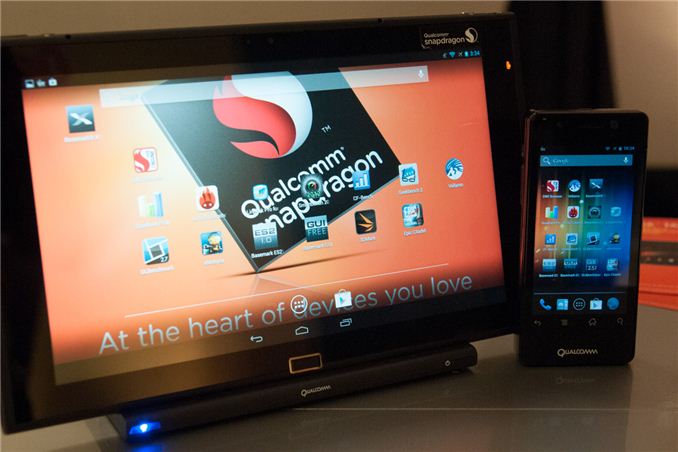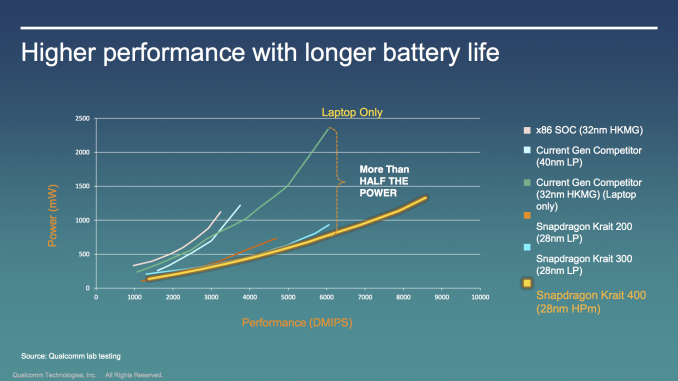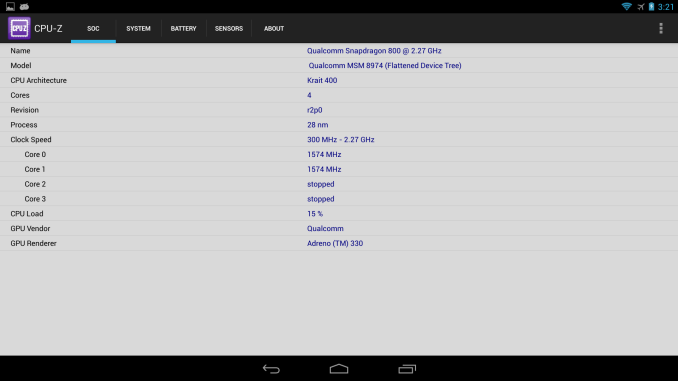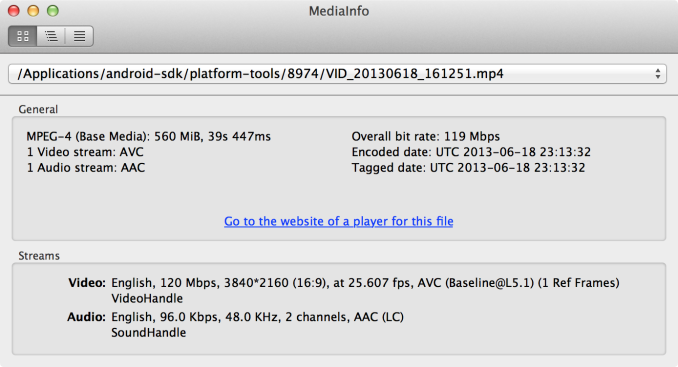Snapdragon 800 (MSM8974) Performance Preview: Qualcomm Mobile Development Tablet Tested
by Brian Klug on June 18, 2013 8:00 PM EST
We’ve written about Snapdragon 800 (MSM8974) before, for those unfamiliar, this is Qualcomm’s new flagship SoC with four Krait 400 CPUs at up to 2.3 GHz, Adreno 330 graphics, and the latest modem IP block with Category 4 LTE. Qualcomm is finally ready to show off MSM8974 performance on final silicon and board support software, and invited us and a few other publications out to San Francisco for a day of benchmarking and poking around. We looked at MSM8974 on both the familiar MSM8974 MDP/T, a development tablet used both by Qualcomm and 3rd parties to develop drivers and platform support, and the MSM8974 MDP phone, both of which have been publicly announced for some time now.
The tablet MDP is what you’d expect, an engineering platform designed for Qualcomm and other third parties to use while developing software support for features. Subjectively it’s thinner and more svelte than the APQ8064 MDP/T we saw last year, but as always OEMs will have the final control over industrial design and what features they choose to expose. Display is 1080p on the tablet and 720p on the phone, a bit low considering the resolutions handset and tablet markers are going for (at least 1080p on phone and WQXGA on tablets) so keep that in mind when looking at on-screen results from benchmarks.
| Qualcomm Snapdragon 800 Mobile Development Platform Tablet | |
| MSM8974 MDP/T | |
| SoC | MSM8974 Snapdragon 800 |
| CPU | 4x Krait 400 at 2.3 GHz |
| GPU | Adreno 330 at 450 MHz |
| RAM | 2GB 2x32 LPDDR3 800 MHz |
| NAND | 32 GB eMMC 4.5 |
| Cameras | 12 MP with flash (rear), 2 MP (front) |
| Display | 11.6-inch 1080p |
| I/O | USB 3.0, microHDMI, microSD, 3.5mm headset |
| OS | Android 4.2 |
Snapdragon 800, nee MSM8974 is built on TSMC’s 28nm HPM (High Performance for Mobile) HK-MG, as opposed to 28nm LP polysilicon (low power). The result are higher clocks for CPU, from 1.5–1.7 GHz on Krait 200–300 which was 28nm LP, to 2.2–2.3 GHz on Krait 400 on 28nm HPM. The jump between Krait 200 and Krait 300 brought higher clocks and also a jump in IPC, this time around Krait 400 is essentially a Krait 300 implemented on 28nm HPM, which means some relayout. There’s also a faster L2 cache on Krait 400.
These are final clocks on MSM8974 – Krait 400 runs its four cores at up to 2.3 GHz, though some lots will come at 2.2 GHz. GPU on MSM8974 is Adreno 330 which runs at 450 MHz and brings some architectural improvements over Adreno 320.
On the video side, MSM8974 is capable of encoding UHD 4K (3840 x 2160) 30 FPS video at up to 120 Mbps H.264 High Profile, and is capable of playing back the same file. Qualcomm had a demo going showing this mirrored on the latest Sony 4K UHD TV as well over microHDMI. I recorded a video sample and took a copy for your perusal and onto YouTube. True to their word the video I grabbed is 120 Mbps and 3840 x 2160, framerate was just over 25 FPS but I'm not sure if the demo was setup for 30 FPS capture. MSM8974 has the hardware encoder for H.264 but not HEVC H.265, that's implemented in software.
Snapdragon 800 should begin popping up in phones and tablets fall 2013. Anyhow let's take a look at MSM8974 performance.

























115 Comments
View All Comments
althaz - Tuesday, June 18, 2013 - link
*Their*I'm not sure you could call them the Intel of Mobile. There's a couple of key differences - the first and most obvious being that Intel is leading in x86 IPC, power management and, this is the big difference, manufacturing. Intel won't and can't go away because they have a tangible advantage over their competitors that will require incredible investment to overcome.
The other is that Qualcomm have a large slice of an ever-increasing pie, but Intel have basically the whole x86 cake to themselves, with the crumbs falling to AMD.
It's probably also worth mentioning that Qualcomm seem better at producing the right improvements for consumers, wheras Intel were late to the low-power party and slow to get going on graphics to (although both are clear foci of the company now).
Interestingly, I believe Qualcomm's mobile division is basically AMD/ATI's old mobile division, which they didn't think was worth it to keep. That's looking a like a pretty huge mistake right now.
tuxRoller - Wednesday, June 19, 2013 - link
Thanks for the grammar correction, teach. Now that I know it any way you can teach it to my phones keyboard? Grammar is useful for helping to avoid ambiguity but the previous could only be understood one way. IOW, your correction wasn't needed unless you were just being anal.You make some good points and it's clear that not clear what it means when someone says "X is the Intel of Y". Intel using their fab is certainly a part of their success. That they are THE key x86 player is, I think, the more important touchstone. It was that which I was speaking of when I spoke of them. I THINK they are, by far, the biggest, most profitable supplier of ARM based SoC in the world. Samsung is huge but they consume what they make. TI is leaving the mobile field and haven't had a major design win for awhile.
BTW you're right about ATI and adreno but the 300+ series is vastly different from the architectures Qualcomm inherited from ATI.
FwFred - Tuesday, June 18, 2013 - link
Very inconclusive without any power measurements. In its tablet reference form factor certainly beats modern SoCs in phone form factors. I'd like to see it against Tegra 4, Bay Trail, and Haswell (4.5W SDP) in a tablet form factor.grahaman27 - Tuesday, June 18, 2013 - link
I second that.aryonoco - Wednesday, June 19, 2013 - link
I agree, I want to see it next to Tegra 4, Bay Trail, and also Kabini and Temash.But I have to say, it looks good, really good. Especially that GPU.
To think that Adreno was AMD/ATI's embedded graphics division that AMD didn't think was worth anything and sold for peanuts (something like $30M IIRC) to Qualcomm. Dirk Meyer really ruined that company.
FwFred - Wednesday, June 19, 2013 - link
Doh, totally forgot about Temash. I was trying to think of all the fanless tablet SoCs coming out.wsw1982 - Thursday, June 20, 2013 - link
The engadget has the benchmark for snapdragon on phone and tablet. It can be seen that the snapdragon 800 is very fast in tablet setup, but only little bit faster than snapdragon 600 in phone setup. I guess this partly answered your TDP concern.http://www.engadget.com/2013/06/18/qualcomm-snapdr...
iwod - Tuesday, June 18, 2013 - link
I Love the Equalizer Part. Finally we have some sense of how far we are from Mainstream Desktop Performance. Would be great if Haswell were added to the Chart, and a UL Haswell running at similar Power usage in there as well. ( Although i believe Intel would properly pressure Anand not to have done so )Impulses - Wednesday, June 19, 2013 - link
Can't believe how far behind Atom's GPU is at this point and how long Intel sandbagged the market with it...I've been rather disconnected from the Android news/rumor mill, any chance Snapdragon makes it into the next small Nexus tablet design? I really wanna downsize/upgrade from my OG Transformer...
Impulses - Wednesday, June 19, 2013 - link
Meant Snapdragon 800, obviously.